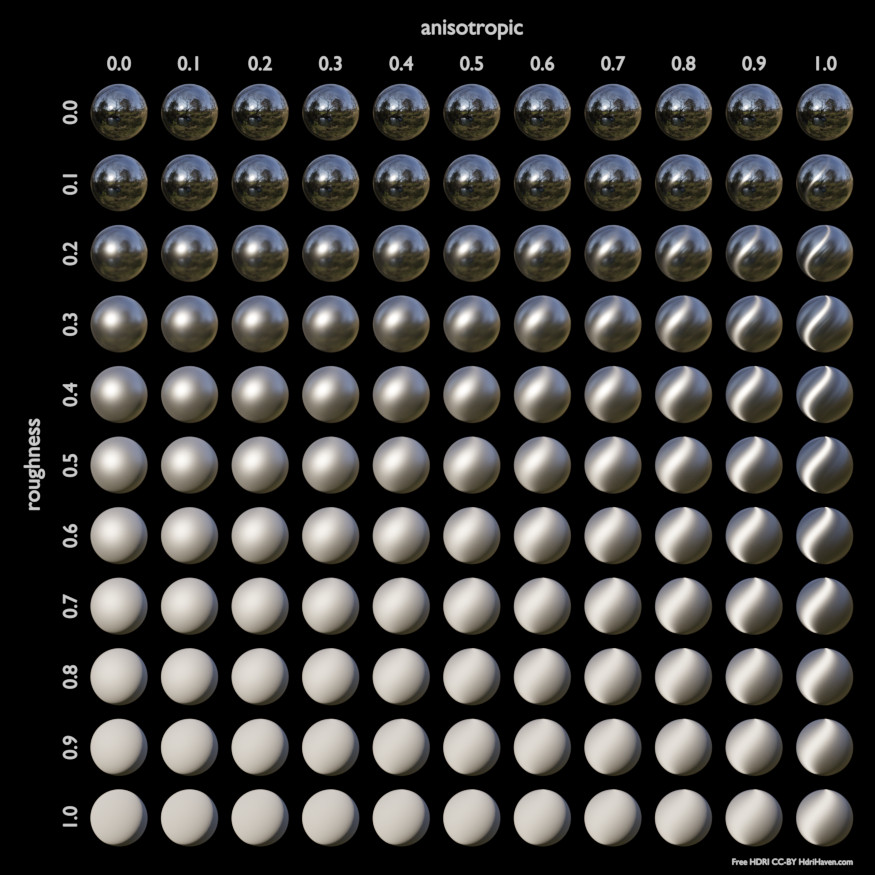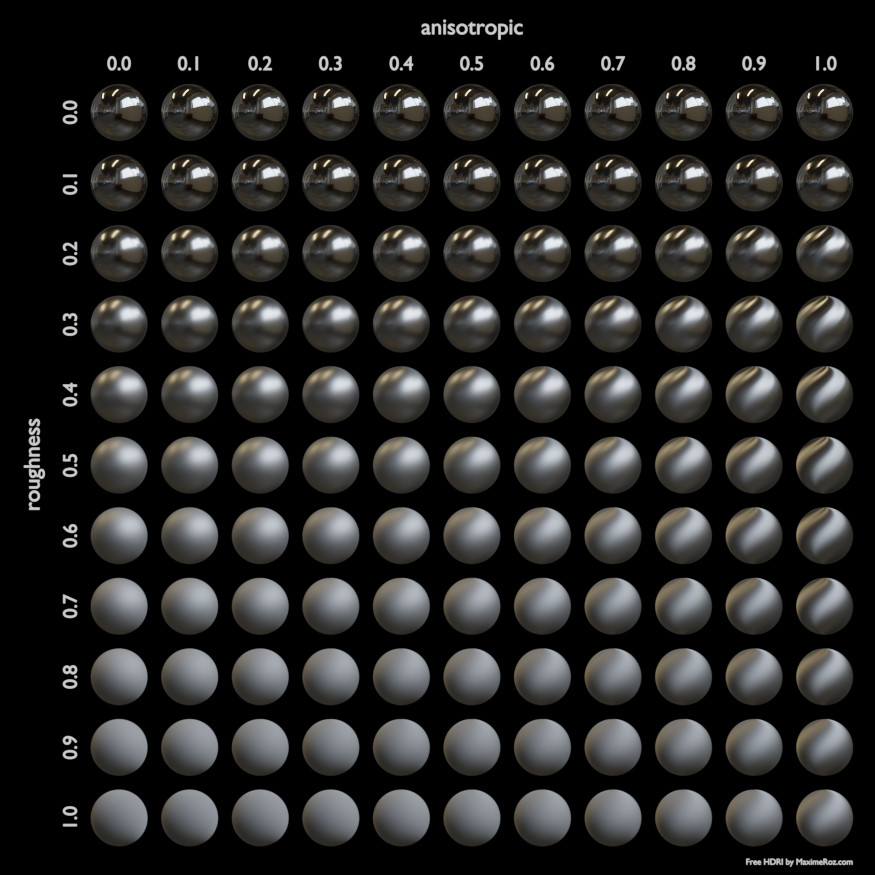BSDF Nguyên Tắc (Principled BSDF)

The Principled BSDF that combines multiple layers into a single easy to use node. It is based on the Disney principled model also known as the "PBR" shader, making it compatible with other software such as Pixar's Renderman® and Unreal Engine®. Image textures painted or baked from software like Substance Painter® may be directly linked to the corresponding parameters in this shader.
This "Uber" shader includes multiple layers to create a wide variety of materials. The base layer is a user controlled mix between diffuse, metal, subsurface scattering and transmission. On top of that there is a specular layer, sheen layer and clearcoat layer.
Ghi chú
The emphasis on compatibility with other software means that it interprets certain input parameters differently from older Blender nodes.
Đầu Vào (Inputs)
- Màu Cơ Sở (Base Color)
Màu khuếch tán hoặc màu kim loại của.
- Dưới Bề Mặt (Subsurface)
Mix between diffuse and subsurface scattering. Rather than being a simple mix between Diffuse and Subsurface Scattering, it acts as a multiplier for the Subsurface Radius.
- Subsurface Radius
Khoảng cách trung bình mà ánh sáng tán xạ ra dưới bề mặt. Bán kính lớn hơn sẽ cho hiện trạng mềm mại hơn vì ánh sáng xâm nhập vào các vùng tối và đi xuyên qua đối tượng. khoảng cách tán xạ sẽ được xác định riêng biệt cho các kênh RGB, để kết xuất nguyên vật liệu giống như da thịt, cái mà ánh sáng đỏ nguồn phân tán sâu hơn. Các giá trị X, Y và Z được là Ánh Xạ sang các giá trị R, G và B trong cặp đôi tương ứng.
- Subsurface Color
Subsurface scattering base color.
- Subsurface IOR Cycles Only
Index of refraction for "Tán Xạ Dưới Bề Mặt".
- Subsurface Anisotropy Cycles Only
Controls the directionality of subsurface scattering.
- Kim Loại (Metallic)
Pha trộn giữa chế độ nguyên vật liệu phi kim loại và kim loại. giá trị 1.0 cho ánh phản quang khuếch tán toàn phần, có nhuốm màu sắc của màu cơ sở, song không có tính phản quang khuếch tán hoặc tính truyền xạ. Tại 0.0 nguyên vật liệu chỉ chứa một tầng khuếch tán hoặc truyền xạ cơ sở, với tầng phản quang nằm trên cùng.
- Lóng Lánh (Specular)
Amount of dielectric specular reflection. Specifies facing (along normal) reflectivity in the most common 0 - 8% range.
Gợi ý
To compute this value for a realistic material with a known index of refraction, you may use this special case of the Fresnel formula: \(specular = ((ior - 1)/(ior + 1))^2 / 0.08\)
Lấy ví dụ:
water: ior = 1.33, specular = 0.25
glass: ior = 1.5, specular = 0.5
diamond: ior = 2.417, specular = 2.15
Since materials with reflectivity above 8% do exist, the field allows values above 1.
- Specular Tint
Tints the facing specular reflection using the base color, while glancing reflection remains white.
Normal dielectrics have colorless reflection, so this parameter is not technically physically correct and is provided for faking the appearance of materials with complex surface structure.
- Độ Nhám/Ráp/Rối (Roughness)
Xác định độ nhám của các vi mặt cắt trên bề mặt trong phản quang ánh lóng lánh và độ khuếch xạ của nó.
- Dị hướng Duy Cycles (Cycles Only)
Amount of anisotropy for specular reflection. Higher values give elongated highlights along the tangent direction; negative values give highlights shaped perpendicular to the tangent direction.
- Xoay Chiều Dị Hướng Duy Cycles (Cycles Only)
Rotates the direction of anisotropy, with 1.0 going full circle.
Gợi ý
Compared to the Anisotropic BSDF node, the direction of highlight elongation is rotated by 90°. Add 0.25 to the value to correct.
- Nước Láng Bóng (Sheen)
Amount of soft velvet like reflection near edges, for simulating materials such as cloth.
- Sheen Tint
Mix between white and using base color for sheen reflection.
- Lớp Tráng Bóng Trong (Clearcoat)
Lớp bổ sung ánh lóng lánh màu trắng trên cùng các lớp khác. Lớp này có tác dụng đối với các nguyên vật liệu như lớp sơn tráng trên xe ô-tô, và những cái tương tự.
- Clearcoat Roughness:
Roughness of clearcoat specular.
- IOR
Index of refraction for transmission.
- Truyền Xạ (Transmission)
Mix between fully opaque surface at zero and fully glass like transmission at one.
- Transmission Roughness Cycles Only
With GGX distribution controls roughness used for transmitted light.
- Phát Xạ (Emission)
Light emission from the surface, like the Emission shader.
- Cường Độ Phát Xạ (Emission Strength)
Strength of the emitted light. A value of 1.0 will ensure that the object in the image has the exact same color as the Emission Color, i.e. make it 'shadeless'.
- Độ Đục (Alpha)
Controls the transparency of the surface, with 1.0 fully opaque. Usually linked to the Alpha output of an Image Texture node.
- Normal (Pháp Tuyến/Bình Thường)
Điều Khiển pháp tuyến của các tầng cơ sở.
- Clearcoat Normal
Controls the normals of the Clearcoat layer.
- Tangent (Tang/Tiếp Tuyến)
Controls the tangent for the Anisotropic layer.
Tính Chất (Properties)
- Phân Bổ (Distribution)
Phép phân bổ của các Microfacet để sử dụng.
- GGX:
A method that is faster than Multiple-scattering GGX but is less physically accurate. Selecting it enables the Transmission Roughness input.
- Multiple-scattering GGX:
Takes multiple bounce (scattering) events between microfacets into account. This gives a more energy conserving results, which would otherwise be visible as excessive darkening.
- Phương Pháp Tán Xạ Dưới Bề Mặt (Subsurface Method)
Phương pháp kết xuất để mô phỏng tán xạ dưới bề mặt.
Ghi chú
Eevee does use not support the Random Walk methods.
- (Christensen-Burley) (Christensen-Burley):
An approximation to physically-based volume scattering. This method is less accurate than Random Walk however, in some situations this method will resolve noise faster.
- Tiến Bước Ngẫu Nhiên [Bán kính cố định] (Random Walk [Fixed Radius]):
Provides accurate results for thin and curved objects. Random Walk uses true volumetric scattering inside the mesh, which means that it works best for closed meshes. Overlapping faces and holes in the mesh can cause problems.
- Tiến Bước Ngẫu Nhiên (Random Walk):
Behaves similarly to Random Walk (Fixed Radius) but modulates the Subsurface Radius based on the Color, Subsurface Anisotropy, and Subsurface IOR. This method thereby attempts to retain greater surface detail and color than Random Walk (Fixed Radius).
Đầu Ra (Outputs)
- Bidirectional Scattering Distribution Function: Hàm Phân Bổ Tán Xạ Hai Chiều
Đầu ra chuẩn của bộ tô bóng.
Một Số Ví Dụ (Examples)
Below are some examples of how all the Principled BSDF's parameters interact with each other.


